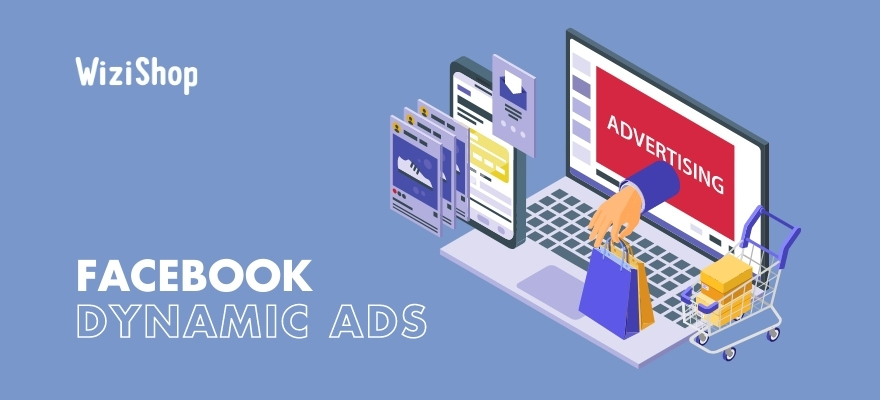As part of a development process in the ecommerce sector, the most reputable social networks offer new resources to online sellers to promote their offer and sell more.
At the same time, more and more online shoppers are using social networks to decide to purchase a good or a service. Leading the way, Facebook has never hidden its ambition to bring its platform closer to online sales.
The most popular social network in the world has approximately 2.93 billion users worldwide. This means that there are many opportunities to help reach potential customers with targeting and retargeting based on the user's profile and the plethora of information that Facebook has in its possession.
Among its initiatives, the social network giant has launched an advertising format specially dedicated to e-retailers: Facebook dynamic ads. What are they? How do you go about creating a campaign successfully for your online store? We tell you everything you need to know in this article!
The influence of social networks in ecommerce
The influence of social networks on the shopping process is undisputed, whether you opt to sell on Instagram, Facebook, or any other platform. Influencer marketing, affiliation, or the sharing of posts on social networks are all elements that help consumers in their shopping, in order to choose the best articles according to their expectations.
Although people previously used social networks only to share their after-sales opinions, they’re now at the heart of the online shopping process, from the discovery of the item to the after-sales service. Thanks to social networks, people will have access to the information that they need, which can help to increase the chances of converting them into customers of an online store.
Ratings, reviews, comments from users, photos, videos, blog posts, etc. All these types of content can encourage the user in the purchasing act and bring them the greatest number of arguments possible online so that they can make a choice.
Advertising is also a vector of inspiration and acquisition. To do this, the Facebook platform, the social network most preferred by marketers according to the Hubspot 2021 study, is quite relevant to boost your results.
In order to reach a maximum number of people, Facebook offers several promotion formats to advertise online and meet the different needs of advertisers. All forms of ecommerce can be represented in order to achieve various objectives:
- acquisition of fans for brand awareness,
- traffic generation to attract prospects to your ecommerce website,
- engagement with an application,
- etc.
What are Facebook dynamic ads?
Dynamic campaigns, or Facebook dynamic ads, are multi-device, multi-place ads, in several forms, such as a carousel, a set of photo ads, etc.
From a specific ad template, Facebook will create a campaign with delivery optimization. The data sources collected are from your product feed. From Business Manager, you’ll be able to configure your ads marketing strategy. Returns on investment are much faster with this advertising model.
In addition to the ability to promote multiple products or product categories from their catalog, with Facebook dynamic ads, merchants can customize their creative ecommerce advertising campaigns throughout the customer's shopping journey, from product discovery to the final transaction, with the implementation of remarketing and/or acquisition campaigns.
Since its launch, billions of products have already been imported!
Dynamic ads will bring considerable advantages compared to a classic advertising model when using Facebook for ecommerce. The targeting of ads can be done manually or automatically, based on content such as a user’s interests, affinities, or location, in order to find the most potential customers possible.
You present your products as you wish, through several angles, several formats, to optimize your presence. You can propose cross-selling products or remarketing campaigns dedicated to your visitors based on page views, for example. Physical products will be highlighted to the most qualified buyers!
The benefits are very interesting:
- Time savings: the setup is optimized with only one ad content. You don't have to set up your ads one by one thanks to the optimized import options.
- Continuously visible and scalable ads: if you choose to set the bids automatically, the artificial intelligence will manage the optimal targeting of your ads.
- A "cross-device" impact of your campaigns: in the long term, your ads can be configured to reach a maximum number of users and target potential customers on Facebook and Instagram, encouraging them to make a purchase.
- Relevance and personalization of the message: 67% of internet users appreciate companies that personalize their ads and content according to their location. Be “global” but think “local!”
Dynamic advertising on Facebook allows you to advertise, in an automatic way, by targeting people who have expressed a certain interest in your article and your services. By being integrated directly into Facebook’s Feed, the network uses the URL of your products to present the products to the most relevant users, but also during their searches, in an instantaneous manner.
Facebook offers different formats for creating a dynamic ad: the Carousel, the Single Image or the Collection, like a mini-catalog.
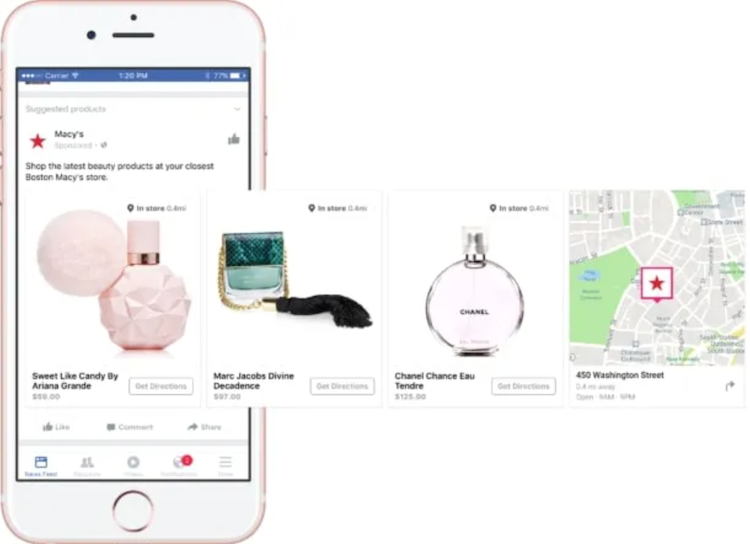
Through the Facebook pixel that you’ve installed in the HTML code on your website, the social network will use the different products in your catalog to retransmit them in ad format to the right people. Travel categories, fashion, household appliances... No matter what your product themes are, your ads will be displayed as they should be!
You can even create offers and promotions to invite your target audience to convert more or boost your online store’s page views and cart additions, for an optimal return on investment!
Pricing, tracking, analysis... Steps for creating a dynamic ad
Create the product feed
Before creating your ad, you must first define a catalog that contains the different characteristics of your products.
You have several formats to import it: with a spreadsheet in CSV format, by automatic retrieval from your WiziShop administration area, or via a Google Sheets file.
Your catalog must contain the following attributes:
- [id]: a sequence of numbers and letters to identify the item, preferably the SKU of the item if possible. For this element, the code must be the same as the code in your Facebook Pixel for the same item. The maximum number of characters is 100.
- [title]: the title must be specific and less than 150 characters long, without capital letters, exclamation marks, or HTML code.
- [description]: it must be short and relevant, less than 5,000 characters. Only the first 30 characters are published; the rest allow Facebook to determine the relevance of your product.
- [availability]: this is the current availability, either "in stock," "out of stock," or "available for order." Facebook won’t display items that are out of stock.
- [condition]: the condition of the item can be "new," "refurbished," or "used." For a new item, the brand and GTIN are required.
- [price]: the price of the item must be entered according to the ISO 4217 standard, i.e., the 3-letter code (EUR) and no symbol. The price indicated must correspond to the price indicated on the landing page.
- [link]: the URL to your website must start with http:// or https://.
- [image_link]: this is the URL of your main visual. Accepted formats are GIF, JPEG, and PNG. For the carousel, the recommended size is 500 x 500 px and 8 MB maximum. The visual must not contain more than 20% of text and clearly represent your product, and the product must be the main element of the visual.
- [brand]: you must fill in one of these three values, either the brand, the GTIN (Global Trade Item Numbers), or the MPN (Manufacturer Part Numbers). Make sure that you don’t exceed 100 characters.
Other fields are optional:
- [additional_image_link]: the platform advises to show more than 4 unique images per product to improve your performance, preferably from different angles.
- [color]
- [material]
- [sale_price]
- [expiration_date]
- [product_type]
- [gender]
- etc...
With WiziShop, we’ll see that this work can be done almost automatically!
In order for your dynamic ads to have the greatest impact on your target audience, the characteristics provided must be as complete and of the best quality as possible.
Also, once your feed is set up, don't hesitate to check that all the data is up to date, that the prices match, that your URLs work, etc., so that your campaign is always optimized and at its maximum potential.
Facebook allows advertisers to create up to five custom labels ([custom_label_0] to [custom_label_4]) to allow your items to be visible based on your criteria. Seasons, flash operations, new products, sales, etc.: the use of custom labels adapts to all sellers!
Install your Facebook Pixel
To be able to set up your dynamic campaigns, you’ll have to install the Facebook Pixel on your website. This is a piece of HTML code that’ll allow you to have a connection to the tracking of visits, products consulted, all that in connection with Facebook audiences. These are actions or "conversion events" if there is a purchase.
All this data is collected in order to broadcast your ads to a highly qualified audience, to create a link between the Facebook audiences and your website, and to help have a better vision of your results.
On your WiziShop store, installation is a breeze!
- In your Facebook Business Manager, go to Business Settings > Data Sources > Pixels
- Insert the URL of your website
- Select the manual installation option
- Go through all the steps by clicking on "Continue" to get to the page of your Pixel
- Copy your website ID, the code located at the top of your page, under your website name
- Go to your WiziShop administration area, in your settings (the cogwheel icon)
- Click on "Tags & External Services”
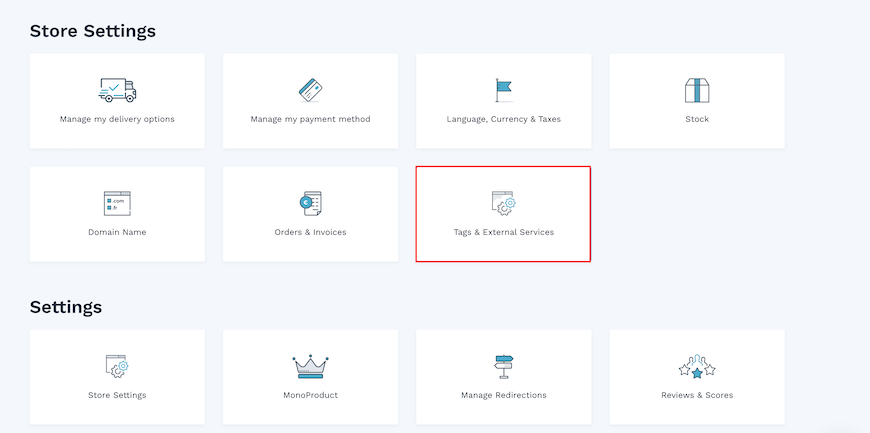
- Select "Facebook/Instagram" in the grid
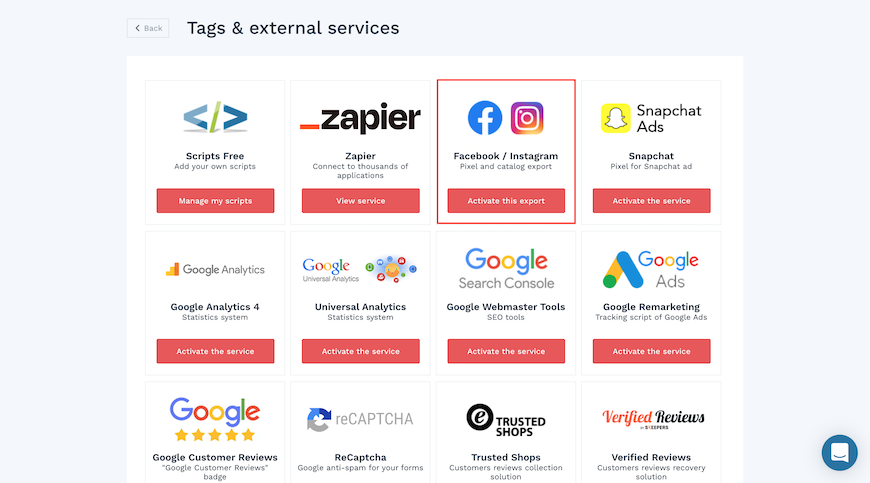
- Paste your website ID in the "Activation" section and you're done!
Import your catalog into Facebook
To get started, you'll need to check in your Facebook Page settings that you've set the "Shopping" template in "Templates and Tabs."
To upload your catalog from the administration area of your website, you can automatically upload it from a CSV file or from a URL. Start by selecting the type of catalog according to your activity and then configure your import parameters, from a WiziShop product feed, for example.
The product feed created on WiziShop must be optimized before importing: in the "Information" tab of your product page, in the "Classification for shopping guides and marketplaces" section, fill in your "google_product_category" for each product page, "SEO" tab, "Additional details for marketplaces" section.
Then, activate the Google Shopping export, and link your categories. For this, go to Marketing > Products export tools, then click on “Activate this export” on the Merchant Center module.
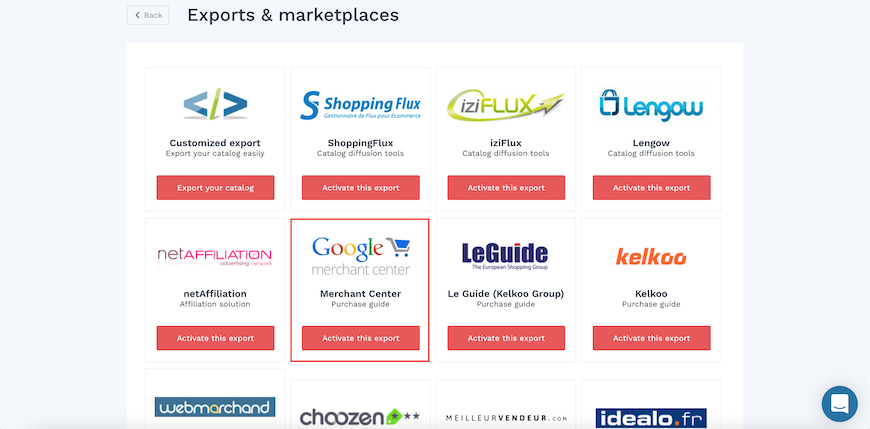
In the "Marketing" > "Other product exports" section, "Facebook/Instagram" module, click now on the "Export" button to get the URL of your catalog to send to Facebook. Click on "All products" to export the whole catalog or select only the selected products.
In Facebook Business Manager, go to "Sales Manager" > "Create a catalog" to import your content. Once your catalog is created, you’ll be able to add items in the "Catalog" > "Data sources" section. With your WiziShop store, select "Import by batch" then "Scheduled feed." The name of the feed will be in XML format and will be found in your WiziShop administration area, at the "Export your catalog" level. Copy and paste this code.
Schedule the catalog update at the time of your choice. Facebook will then retrieve the latest data from your website according to your preferences. We advise you to schedule it at least daily. Add the currency and import your catalog.
The rules of Facebook dynamic ads
To succeed with your dynamic Facebook campaign, to get the maximum return on investment and boost your page views, you need to optimize your ads.
If you decide to promote only a single visual, focus on exclusivity and on the creative side of your shot to push your target audience to interact with your ad and encourage conversion events. For the carousel, your five images should be unique and add a lot to your ad.
Besides having creative images, note that formats must be square, 1:1 ratio or 1080 x 1080 pixels, and less than 1MB in size.
Texts are limited in number of characters:
- Title: 40 characters
- Text above the description: 125 characters
- Link description: 25 characters
The creation of the campaign
Here are the steps to create your campaign:
- Go to your Ads Manager on your Facebook Business Manager
- Click on the "+ Create" button
- Then, set up your Facebook campaign and choose "Catalog Sales" as your objective in the conversion tab.
- Select your catalog by choosing the products you want to highlight.
- Finally, choose your audience according to your Facebook pixel, your ad placement, your budget and your schedule.
Once you've finished creating your ad set, all you have to do is define a template for your dynamic ad. As mentioned above, you can choose between carousel, single visual, and collection, depending on your goals for conversion events.
Download the free Facebook dynamics ads guide
To help you in the creation and optimization of your dynamic campaigns and entice shoppers in your target audience to make a purchase, the feed manager Lengow has published a complete white paper, to download for free.
This will help you learn how to boost your sales on Facebook and Instagram. This involves setting up efficient bids, defining your audience, thinking about the placement of your ads to best reach current and potential customers alike... For sure, this free guide will help you to learn everything about dynamic ads to boost your business and your website!


